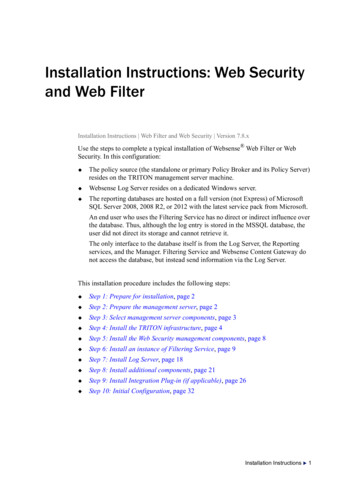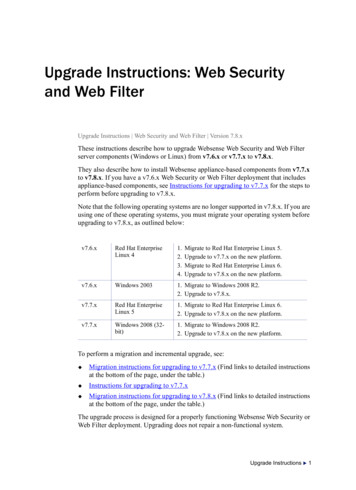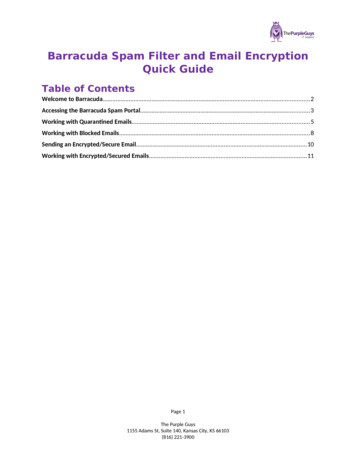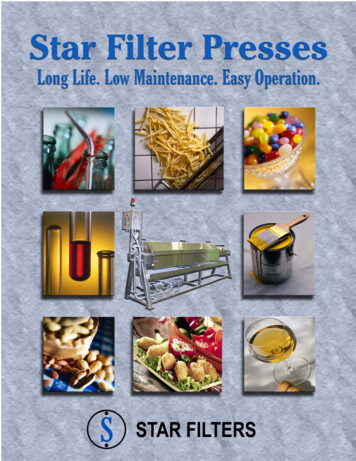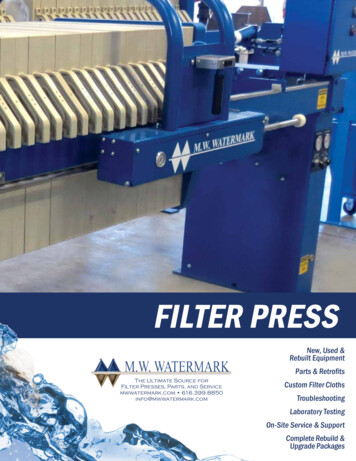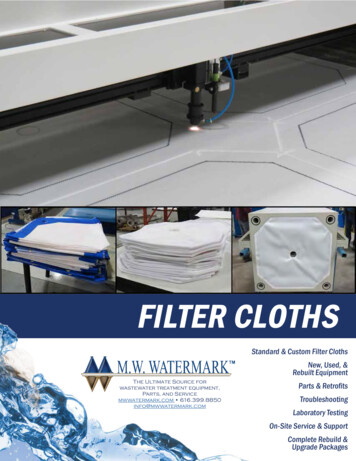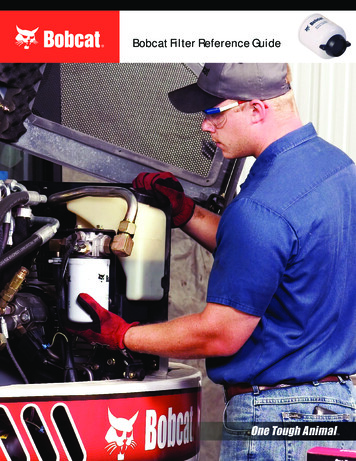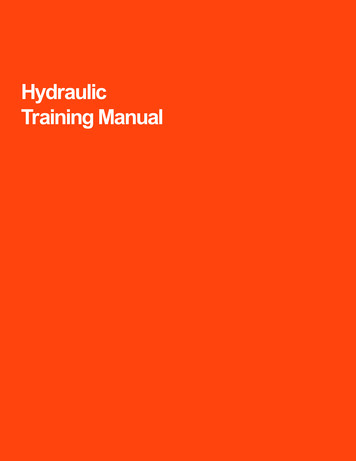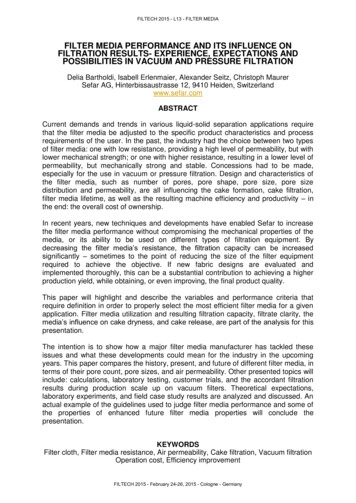
Transcription
FILTECH 2015 - L13 - FILTER MEDIAFILTER MEDIA PERFORMANCE AND ITS INFLUENCE ONFILTRATION RESULTS- EXPERIENCE, EXPECTATIONS ANDPOSSIBILITIES IN VACUUM AND PRESSURE FILTRATIONDelia Bartholdi, Isabell Erlenmaier, Alexander Seitz, Christoph MaurerSefar AG, Hinterbissaustrasse 12, 9410 Heiden, Switzerlandwww.sefar.comABSTRACTCurrent demands and trends in various liquid-solid separation applications requirethat the filter media be adjusted to the specific product characteristics and processrequirements of the user. In the past, the industry had the choice between two typesof filter media: one with low resistance, providing a high level of permeability, but withlower mechanical strength; or one with higher resistance, resulting in a lower level ofpermeability, but mechanically strong and stable. Concessions had to be made,especially for the use in vacuum or pressure filtration. Design and characteristics ofthe filter media, such as number of pores, pore shape, pore size, pore sizedistribution and permeability, are all influencing the cake formation, cake filtration,filter media lifetime, as well as the resulting machine efficiency and productivity – inthe end: the overall cost of ownership.In recent years, new techniques and developments have enabled Sefar to increasethe filter media performance without compromising the mechanical properties of themedia, or its ability to be used on different types of filtration equipment. Bydecreasing the filter media’s resistance, the filtration capacity can be increasedsignificantly – sometimes to the point of reducing the size of the filter equipmentrequired to achieve the objective. If new fabric designs are evaluated andimplemented thoroughly, this can be a substantial contribution to achieving a higherproduction yield, while obtaining, or even improving, the final product quality.This paper will highlight and describe the variables and performance criteria thatrequire definition in order to properly select the most efficient filter media for a givenapplication. Filter media utilization and resulting filtration capacity, filtrate clarity, themedia’s influence on cake dryness, and cake release, are part of the analysis for thispresentation.The intention is to show how a major filter media manufacturer has tackled theseissues and what these developments could mean for the industry in the upcomingyears. This paper compares the history, present, and future of different filter media, interms of their pore count, pore sizes, and air permeability. Other presented topics willinclude: calculations, laboratory testing, customer trials, and the accordant filtrationresults during production scale up on vacuum filters. Theoretical expectations,laboratory experiments, and field case study results are analyzed and discussed. Anactual example of the guidelines used to judge filter media performance and some ofthe properties of enhanced future filter media properties will conclude thepresentation.KEYWORDSFilter cloth, Filter media resistance, Air permeability, Cake filtration, Vacuum filtrationOperation cost, Efficiency improvementFILTECH 2015 - February 24-26, 2015 - Cologne - Germany
FILTECH 2015 - L13 - FILTER MEDIA1. Introduction- history and development of woven filter mediaSeparation systems are used in many industries to remove undesired compounds orto recover desired ones. These systems are utilized for many purposes includingpurification, concentration and clarification of suspensions, washing of processedproducts and management of wastes. As one method of filtration, the cake filtrationprovides a particularly flexible way of the wide ranging array of physically differentpossibilities for the separation of particles from suspensions. In combination withdifferent treatment possibilities (i.e. concentration, agglomeration), a particle range ofseveral millimeters, down to some microns is covered. The various equipmentdesigns and operating principles of cake forming filter devices require customizedand specially matched filter media to meet the mechanical requirements of the filterunit (3). Solid liquid separation processes and used auxiliary material had to adapt tothe increasing demands and the filter media has undergone a huge developmentover the last decades. As the requirements to the utilized filter media are dependingand varying with the used filtration equipment and the processed materials, differentaspects need to be considered when developing and selecting a filter media for agiven filtration task. In recent years, new techniques have enabled Sefar to drasticallyincrease the filter media permeability and its number of pores per cm 2 (Figure 1)without comprising on their mechanical properties.Pore count of 20µm DLW over the years10'0009'000Pore count W - Gen 1DLW - Gen 2DLW - Gen 3DLW - Gen 4DLW (Double Layer Weave) - Pores count development over generations (Gen)Figure 1: Pore count development of different Double Layer Weave fabric generationsThe improvement of filter media design (i.e. number of pores) showed an impact onthe performance when filter media with comparable pore size are analyzed and usedin the field. This variables and performance influences are shown in this paper tomake it obvious that filter media design and selection have an impact on the filtrationprocess.FILTECH 2015 - February 24-26, 2015 - Cologne - Germany
FILTECH 2015 - L13 - FILTER MEDIA2. Filter media designWoven fabrics are a major part of the type of filter media used in many solid-liquidseparation processes. Design and characteristics of the woven filter media such asyarn raw material, yarn properties, weaving pattern as well as media density andfinishing process directly influence the following filter media characteristics: Pore size and pore size distributionNumber of poresFilter media air and liquid permeabilityResulting flow and percolation resistanceSuitability for the use on the filter equipmentAs an example different structured filter media are displayed below:Figure 2: Multifilament, single layerFigure 3: Monofilament, single layerFigure 4: Mono/ Multifilament Double layer fabricFigure 5: Monofilament, Double layer fabricAll these filter media parameters influencing the following aspects which need to beconsidered during filter media selection: Concentration, surface tension and particle size distribution of the suspensionRequired filtrate clarityResidual cake moisture content acceptanceDesired filtration rateEasy cake dischargeMechanical and thermal performance & dimensional stabilityFILTECH 2015 - February 24-26, 2015 - Cologne - Germany
FILTECH 2015 - L13 - FILTER MEDIAThe specific importance of these aspects is depending on the requirements of thecurrently used process and its auxiliary materials. Crucial for the success of theseparation process is the perfect alignment and further interaction between filtermedia, suspension, utilized machinery and the operation conditions (3).The following chapters compare the design and characteristics of woven filter mediawith aspects of the specific application requirements. Chapter 3 takes a more specificlook at selected filter media design and filtration results in the laboratory, whileChapter 4 & 5 outlines the results in the fields using currently developed filter media.3. Laboratory testingAim of the following filter tests is to compare different filter media with different poresize and/or different weaving construction to judge their filtration performance. Usingthe laboratory filtration results, filter media resistance and the filter cake resistancecan be calculated through the measurement of the filtrate quantity. Also the filtrationtime as well as particle throughput, cake height and cake dryness can be determined.All these parameters are compared to ascertain filter media values.3.1 Filter media characterization for laboratory testingTable 1 shows the chosen filter media. Pore size MPF – Mean Pore Flow isdetermined by Bubble Point based on ASTM F 316-03 measurement (5) – rangesfrom 10 – 30 µm. Mainly DLW (Double Layer Weave) of different generations werechosen: outdated Generation 1 (Gen 1) going up to the standard Gen 2 and thenewest developments of DLW Gen 3 and Gen 4. The development steps in numberof pores of the different Generations were already shown in (chapter 1). Beside theDLW filter media, one Twill (TWL) and one Plain Reversed Dutch (PRD) pattern werechosen to compare their performance with Double Layer Weave fabrics.No. iMono-multiMono-multiMonoMono-multiMonoMultiDLW - Gen 1DLW - Gen 1DLW - Gen 2DLW - Gen 2DLW - Gen 2DLW - Gen 2DLW - Gen 3DLW - Gen 3DLW - Gen 3DLW - Gen 3DLW - Gen 4PRDTWLPore size Pore countAirWaterMFPpermeability permeabilty(1/cm 2)(µm)@ 200 Pa(l/(m 2·s))2(l/(m 5203657251Table 1: Filter media selection utilized for filtration testsFILTECH 2015 - February 24-26, 2015 - Cologne - Germany812411192871319423511744
FILTECH 2015 - L13 - FILTER MEDIAAll chosen filter media were analyzed by determining the mean flow pore pressure(MFP), their air permeability and the water throughput (7). The air permeability andthe (de-ionized) water throughput show a good correlation (Figure 6) – withincreasing air permeability a corresponding increasing water throughput isdetermined.Air permeability vs. water throughput140water trhoughput (l/(m2*s))12010080y 0.1768x - 0.3845R² 0.998160402000100200300400500600700air permeability (l/(m2*s))Figure 6: Air permeability vs. water permeability of different filter media3.2 Filtration test equipment and test procedure3.2.1 Test suspensionThe used suspension has a solid content of 20%. After internal characterization withan optical microscope analysis (Pixelferber imaging software) calcium carbonateCaCO3 (Omya 10H) was selected as solid content (Figure 7). The chosen filter mediaaverage pore sizes are around 1.2 – 2 times the D50 of the CaCO3 particle sizedistribution. All filter tests are carried out with the same suspension to compare thefilter media. Note that other suspensions or concentrations might lead to differentfiltration results.Figure 7: Particle distribution and particle characterization of CaCO3 suspensionFILTECH 2015 - February 24-26, 2015 - Cologne - Germany
FILTECH 2015 - L13 - FILTER MEDIA3.2.2 Test equipmentLaboratory tests are carried out using a pressure nutsch filter test. Figure 8 showsthe schematic set up of the testing equipment as well as the used pressure nutsch.As the goal is to compare different filter media, constant filter test parameters at roomtemperature conditions are used: constant pressure of 0.7 bar, filter volume of 40 ml,filter area of 12.6 cm2, maximum cake height of 25mm and using a standardsuspension (details see chapter 3.2.1). A weighing scale is connected to a computer,recording the filtrate quantity at a specific time.Figure 8: Left: test set up – schematic (1), right: pressure nutsch test equipment3.2.3 Test procedureThe used filter media (see Table 1) is punched out, pre wetted with de-ionized waterand clamped into the pressure nutsch. The used suspension is prepared in a glassbeaker and stirred continuous with a constant speed to make sure that there is nosedimentation and the particle are dispersed homogeneous in the suspension. Thevolume of 40ml for one filter test is taken out using a syringe and is applied on thetest equipment. Time measurement starts immediately. After 10 s pressure is appliedand cake formation time starts. Measurement ends after the cake surface shows nomore brightening and 60 s of ongoing pressure as cake drying time is over. Testprocedure is carried out three times in a row on the same filter media, releasing andscraping cake of filter media. As pre-trials showed, after the third measurementresults get repeatable and variability is low. After third measurement cake height andweight is measured. Wet cake is dried with 80 C at least 8 h and dry cake weight ismeasured afterwards. If required cake dryness (TS) is calculated using followingformula:TS * 100 %Next to the filter cake the filtrate itself is centrifuged, decanted, dried and weight backand determining thereby the quantity of particles in the filtrate – particle throughput.FILTECH 2015 - February 24-26, 2015 - Cologne - Germany
FILTECH 2015 - L13 - FILTER MEDIAFilter media resistance RT and filter cake resistance rc are displayed and can becalculated as characterizing factor. It unifies all influences such as particle size anddistribution, pore shape, porosity and structure of filter cake and filter media. Bothfactors are calculated, analyzing the measured filtrate quantity over time (1), (3).RTaAΔpΗ filter media resistance (1/m) axis intercept a2 filter area (m ) pressure difference (Pa) viscosity liquid (Pa*s)Wherever possible testing equipment, procedure and calculation is based onrecommendations of the VDI guideline 2762 (1).3.3 Filtration ResultsFilter media analysis of air permeability and water permeability (see Figure 6) impliesthat air permeability and throughput on liquids correlates quite well. When filter testare not only done with clean water, but using suspensions – as CaCO3 – filtrationresults can show different tendencies.Figure 9 compares the air permeability to the filtration time of two generations ofDouble Layer Weaves (DLW) with different pore sizes (see Table 1). There is acorrelation between the measured filtration time and the air permeability but only ifcomparing the same generations of DLW. Filtration time of the same suspension notonly depends on the air permeability, but also on the weaving pattern differences:DLW Gen 2 vs. DLW Gen 3. For example – see circled filter media Figure 9 – havingsimilar air permeability, fi
3.1 Filter media characterization for laboratory testing . Table 1. shows the chosen filter media. Pore size MPF – Mean Pore Flow is determined by Bubble Point File Size: 1MBPage Count: 17


